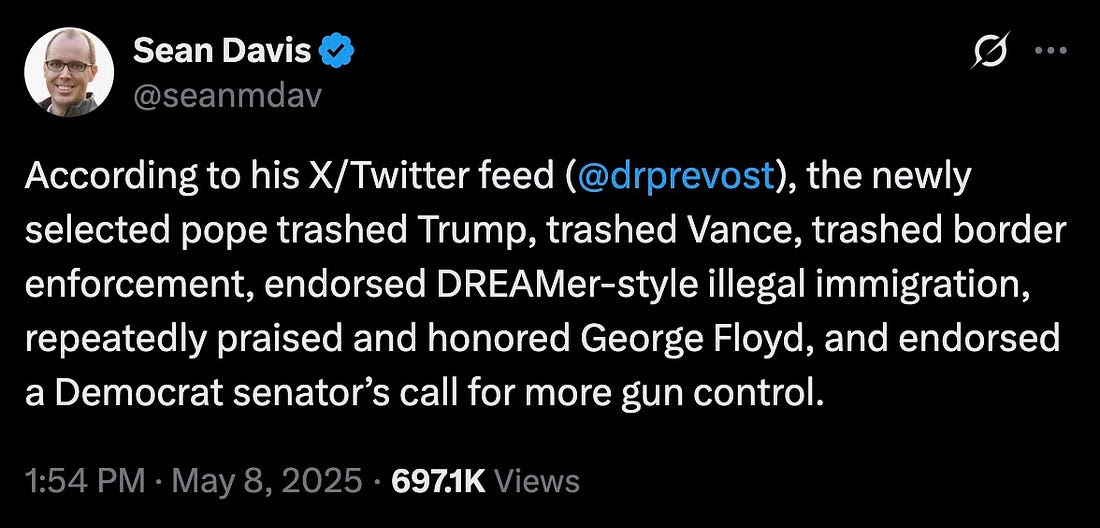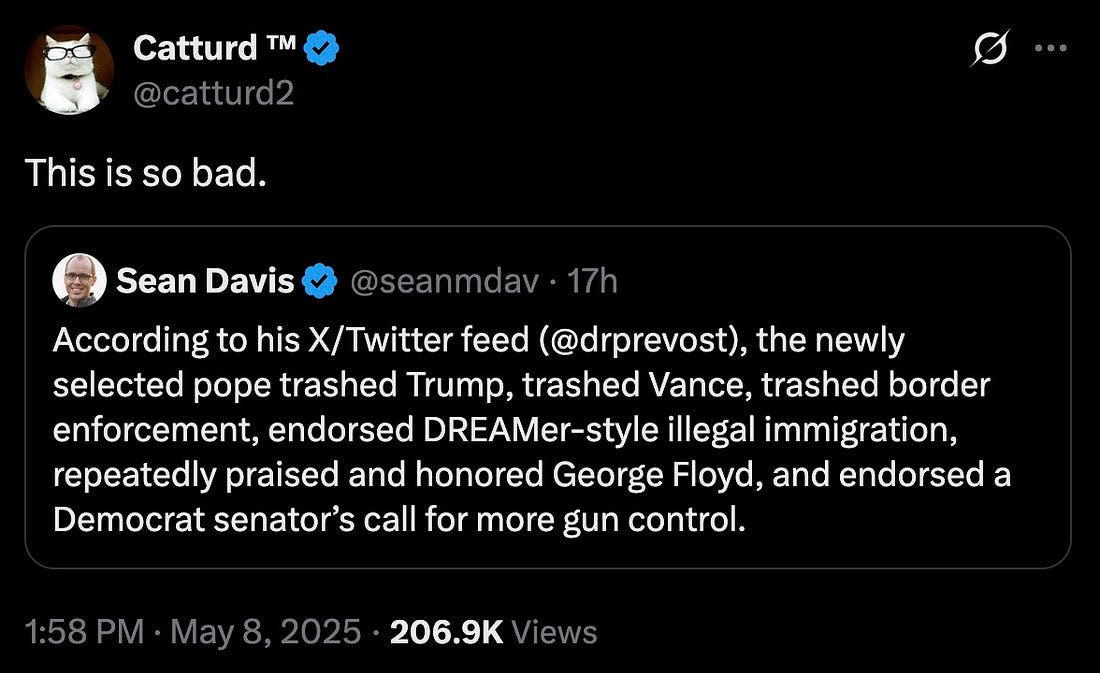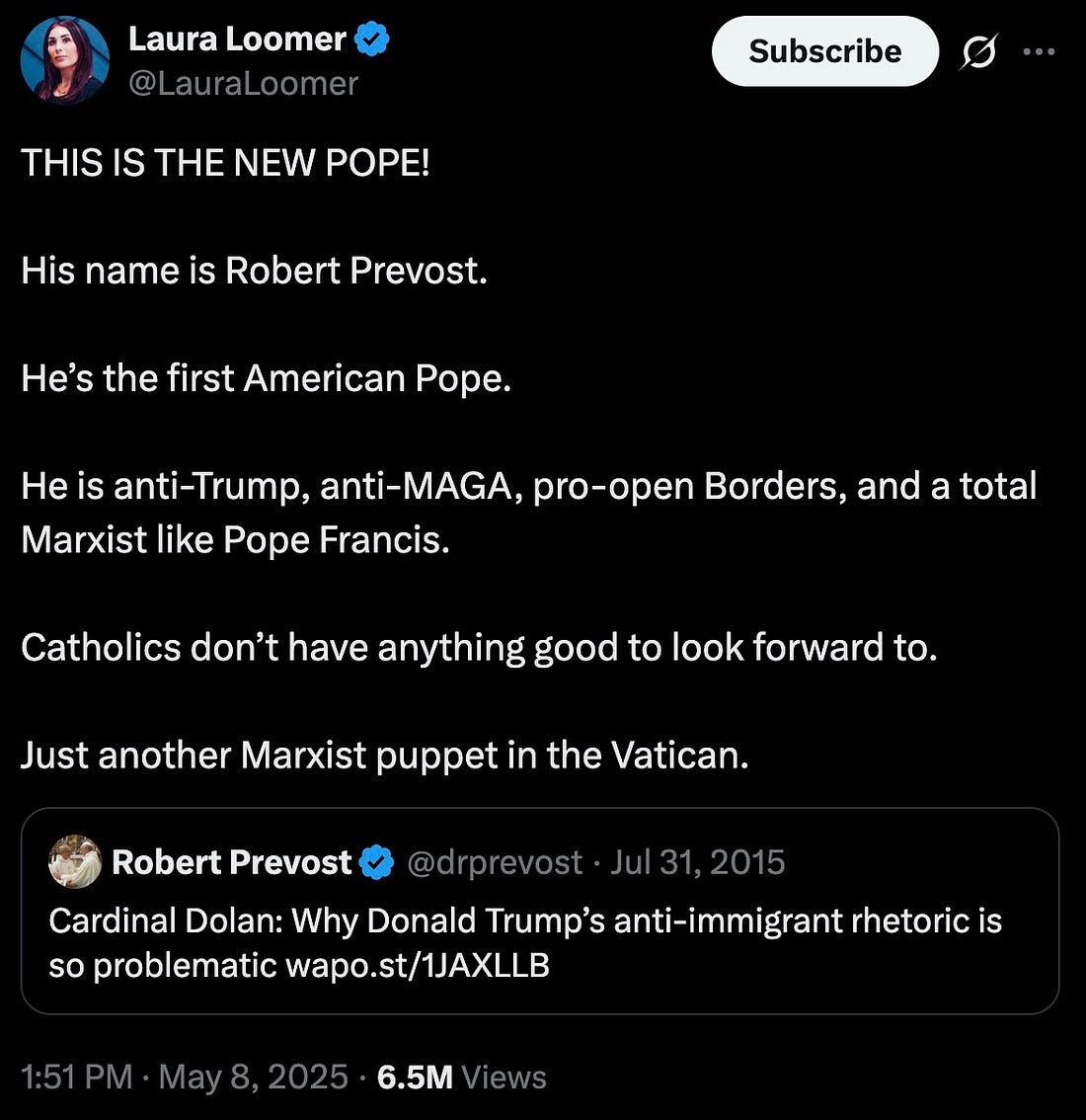Heather Cox Richardson recounts the important exchanges between the new Pope, Leo XIV, and JD Vance, on the subject of immigrants. Vance, a convert to Catholicism, described Catholic doctrine and was quickly rebuffed at the time both by Pope Francis and by the future Pope. So, JD Vance has the dubious distinction of being rebuffed by two Popes!
She writes:
Today, on the second day of the papal conclave, the cardinal electors—133 members of the College of Cardinals who were under the age of 80 when Pope Francis died on April 21—elected a new pope. They chose 69-year-old Cardinal Robert Prevost, who was born in Chicago, thus making him the first pope chosen from the United States. But he spent much of his ministry in Peru and became a citizen of Peru in 2015, making him the first pope from Peru, as well.
New popes choose a papal name to signify the direction of their papacy, and Prevost has chosen to be known as Pope Leo XIV. This is an important nod to Pope Leo XIII, who led the church from 1878 to 1903 and was the father of modern Catholic social teaching. He called for the church to address social and economic issues, and emphasized the dignity of individuals, the common good, community, and taking care of marginalized individuals.
In the midst of the Gilded Age, Leo XIII defended the rights of workers and said that the church had not just the duty to speak about justice and fairness, but also the responsibility to make sure that such equities were accomplished. In his famous 1891 encyclical Rerum Novarum, translated as “Of New Things,” Leo XIII rejected both socialism and unregulated capitalism, and called for the state to protect the rights of individuals.
Prevost’s choice of the name Leo invokes the principles of both Leo XIII and his predecessor, Pope Francis. In his own lifetime he has aligned himself with many of Francis’s social reforms, and his election appears to be a rejection of hard-line right-wing Catholics in the U.S. and elsewhere who have used their religion to support far-right politics.
In the U.S., Vice-President J.D. Vance is one of those hard-line right-wing Catholics. Shortly after taking office in January, Vance began to talk of the concept of ordo amoris, or “order of love,” articulated by Catholic St. Augustine, claiming it justified the MAGA emphasis on family and tribalism and suggesting it justified the mass expulsion of migrants.
Vance told Sean Hannity of the Fox News Channel, “[Y]ou love your family, and then you love your neighbor, and then you love your community, and then you love your fellow citizens in your own country, and then, after that, you can focus and prioritize the rest of the world. A lot of the far left has completely inverted that.” When right-wing influencer Jack Posobiec, who is Catholic, posted Vance’s interview approvingly, Vance added: “Just google ‘ordo amoris.’ Aside from that, the idea that there isn’t a hierarchy of obligations violates basic common sense.”
On February 10, Pope Francis responded in a letter to American bishops. He corrected Vance’s assertion as a false interpretation of Catholic theology. “Christians know very well that it is only by affirming the infinite dignity of all that our own identity as persons and as communities reaches its maturity,” he wrote. “Christian love is not a concentric expansion of interests that little by little extend to other persons and groups…. The true ordo amoristhat must be promoted is that which we discover by…meditating on the love that builds a fraternity open to all, without exception.”
“[W]orrying about personal, community or national identity, apart from these considerations, easily introduces an ideological criterion that distorts social life and imposes the will of the strongest as the criterion of truth,” Pope Francis wrote. He acknowledged “the right of a nation to defend itself and keep communities safe from those who have committed violent or serious crimes while in the country or prior to arrival,” but defended the fundamental dignity of every human being and the fundamental rights of migrants, noting that the “rightly formed conscience” would disagree with any program that “identifies the illegal status of some migrants with criminality.” He continued: “I exhort all the faithful of the Catholic Church, and all men and women of good will, not to give in to narratives that discriminate against and cause unnecessary suffering to our migrant and refugee brothers and sisters.”
The next day, Trump’s border czar, Tom Homan, who said he was “a lifelong Catholic,” told reporters at the White House, “I’ve got harsh words for the Pope…. He ought to fix the Catholic Church and concentrate on his work and leave border enforcement to us.”
Cardinal Prevost was close to Pope Francis, and during this controversy he posted on X after Vance’s assertion but before Pope Francis’s answer: “JD Vance is wrong: Jesus doesn’t ask us to rank our love for others.” After the pope published his letter, Prevost reposted it with the comment: “Pope Francis’ letter, JD Vance’s ‘ordo amoris’ and what the Gospel asks of all of us on immigration.”
On April 14, Prevost reposted: “As Trump & [Salvadoran president Nayib] Bukele use Oval to [laugh at] Feds’ illicit deportation of a US resident [Kilmar Abrego Garcia], once an undoc[ument]ed Salvadorean himself, [Bishop Evelio Menjivar] asks, ‘Do you not see the suffering? Is your conscience not disturbed? How can you stay quiet?’”
The new Pope Leo XIV greeted the world today in Italian and Spanish as he thanked Pope Francis and the other cardinals, and called for the church to “be a missionary Church, building bridges, dialogue, always open to receiving with open arms for everyone…, open to all, to all who need our charity, our presence, dialogue, love…, especially to those who are suffering.”
As an American-born pope in the model of Pope Francis, Pope Leo XIV might be able to appeal to American far-right Catholics and bring them back into the fold. But today, MAGAs responded to the new pope with fury. Right-wing influencer Laura Loomer, who is close to Trump, called Pope Leo “another Marxist puppet in the Vatican.” Influencer Charlie Kirk suggested he was an “[o]pen borders globalist installed to counter Trump.”
In the U.S., President Donald Trump, who said he would like to be pope and then posted a picture of himself dressed as a pope on May 2, prompting an angry backlash against those who thought it was disrespectful, posted on social media that the election of the first pope from the United States was “a Great Honor for our Country” and that he looks forward to meeting him. ‘It will be a very meaningful moment!” he added.










